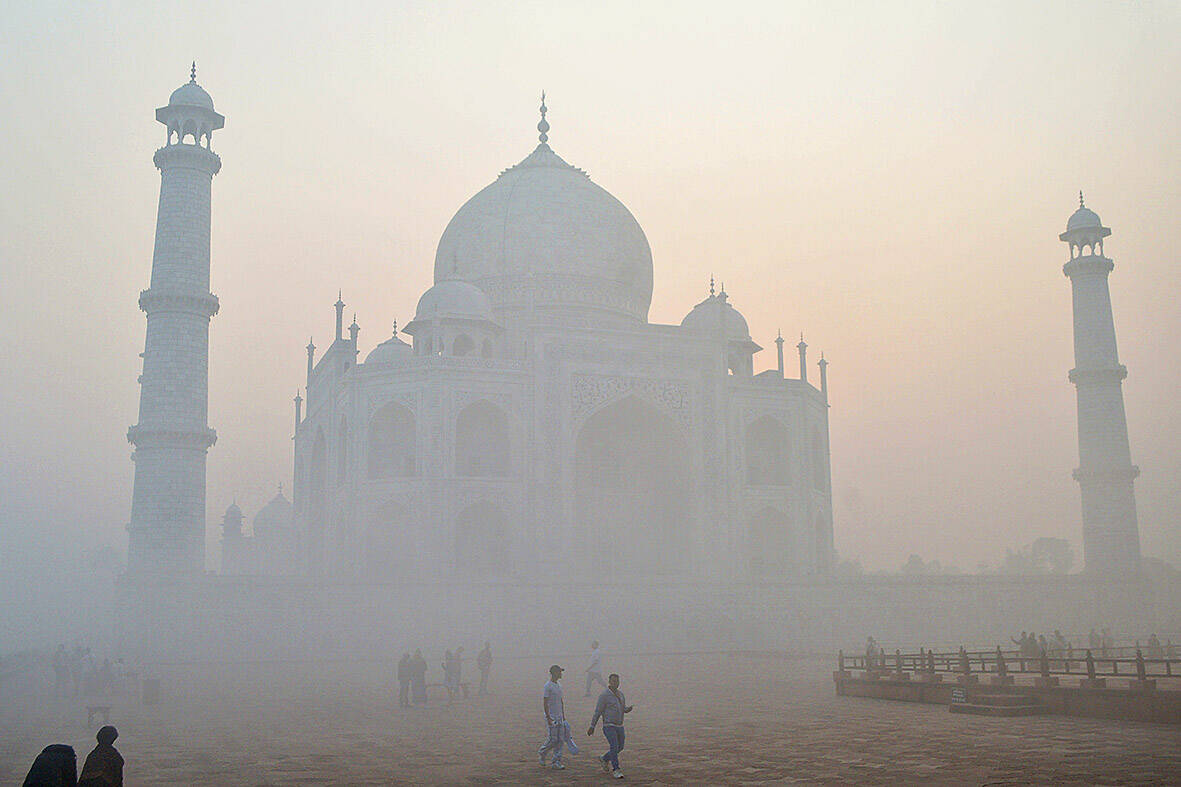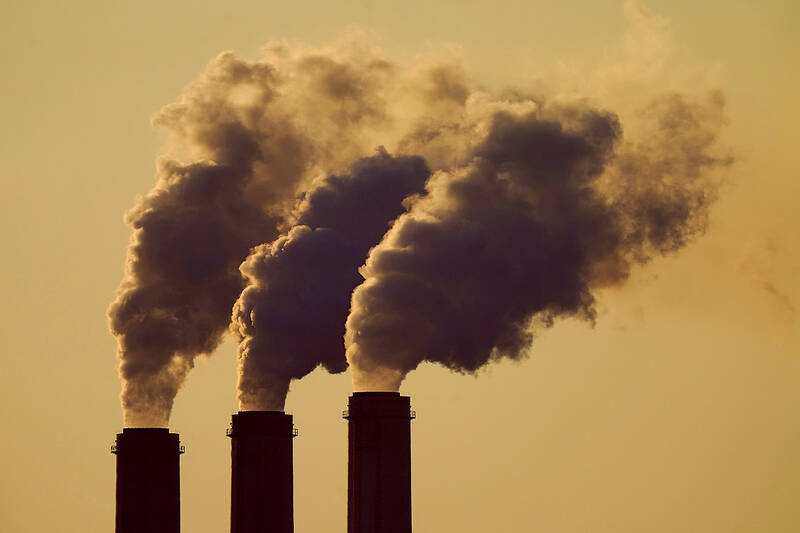Everyone loves a breath of fresh air. Unfortunately, too often our air is anything but fresh.
While air quality varies dramatically from place to place and day to day, nearly the entire world — about 99 percent of the global population — is exposed to air at some point that doesn’t meet the strict standards set by the WHO, the agency has reported. Polluted air, laden noxious gasses or tiny, invisible particles that burrow into human bodies, kills 7 million people prematurely every year, the UN health agency estimates.
And for the millions living in some of the world’s smoggiest cities — many of them in Asia like New Delhi; Dhaka, Bangladesh; Bangkok and Jakarta, Indonesia — bad air might seem inescapable.

Photo: AFP
But there are things that people can do, starting with understanding that the air isn’t only polluted when it looks smoggy, said Tanushree Ganguly of the Energy Policy Institute of Chicago in India.
“Blue skies can’t guarantee you clean air,” she said.
DANGEROUS POLLUTANTS

Photo: AP
What are the most dangerous kinds of air pollutants and their sources?
Air pollutants often come from people burning things: Fuels such as coal, natural gas, diesel and gasoline for electricity and transportation; crops or trees for agricultural purposes or as a result of wildfires.
Fine, inhalable particles, known as particulate matter, are among the most dangerous. The tiniest of these — known as PM 2.5 because they are less than 2.5 microns in diameter — can get deep into human lungs and are mostly created by burning fuels. Coarser particles, known as PM 10, are linked to agriculture, roadways, mining or the wind blowing eroded dust, according to the WHO.

Photo: Reuters
Other dangerous pollutants include gases like nitrogen dioxide or sulfur dioxide, which are also produced from burning fuels, said Anumita Roychowdhury, an air pollution expert at the Center for Science and Environment in New Delhi.
The sources and intensity of air pollution varies in different cities and seasons. For instance, old motorbikes and industrial boilers are major contributors to bad air in Indonesian capital Jakarta while burning of agricultural waste is a major reason for air pollution spikes in cities in Thailand and India. Brick kilns that burn coal adds to pollution in Dhaka, Bangladesh’s capital. And seasonal forest fires cause problems in Brazil and North America.
HEALTH PROBLEMS
What health problems can air pollution cause?
Air pollution is the second-largest risk factor for early death globally, behind high blood pressure, according to a recent report by the Health Effects Institute.
Short-term exposure can trigger asthma attacks and increase the risk of heart attacks and stroke, especially in the elderly or people with medical problems. Long-term exposure can cause serious heart and lung problems that can lead to death, including heart disease, chronic obstructive pulmonary disease and lung infections.
A recent analysis by the UN children’s agency found that more than 500 million children in East Asia and Pacific countries breathe unhealthy air and the pollution is linked to the deaths of 100 children under 5 every day. June Kunugi, UNICEF Regional Director for East Asia, said the polluted air compromises growth, harms lungs and impacts their cognitive abilities.
“Every breath matters, but for too many children every breath can bring harm,” she said.
What’s the best way to tell if air is safe?
AIR QUALITY INDEX
Over 6,000 cities in 117 countries now monitor air quality, and many weather mobile apps include air quality information. But trying to gauge how bad the air is by looking at these numbers can be confusing.
To help people understand air quality levels more easily, many countries have adopted an air quality index or AQI — a numerical scale where larger numbers mean worse air. They are also often assigned different colors to show whether the air is clean or not.
But different countries have different air quality standards. For instance, India’s daily PM 2.5 limit is more than 1.5-times higher than Thailand’s limit and 4-times higher than WHO standards.
This means that countries calculate AQIs differently and the numbers aren’t comparable with each other. This is also why sometimes AQI scores by private companies using stricter standards may be different from those calculated by national regulators.
PROTECTING AGAINST AIR POLLUTION
What are the best ways to protect yourself from air pollution?
The goal, of course, is to limit exposure when air quality is bad, by staying inside or wearing a mask.
Staying inside however, isn’t always possible, especially for people who must live or work outside, noted Danny Djarum, an air quality researcher at World Resources Institute, an environmental advocacy group. “They can’t really afford not going out,” he said.
Pakaphol Asavakomolnant, an office worker in Bangkok, said that he wears a mask every day and avoids riding to work on a motorbike. “I get a sore throat when I come to work in the morning and I forget to wear a mask,” he said.
People also need to be aware of indoor air pollution which can often be caused by common household activities like cooking or even burning an incense stick.
What are the benefits — and limitations — of air purifiers?
Air purifiers can help reduce indoor air pollution, but they have their limitations. They work by pulling air from a room, pushing it through a filter that traps pollutants before circulating it back.
But they’re are most effective when used in small spaces and when people are nearby. Air purifiers can only clean a certain amount of air, said Rajasekhar Balasubramanian, who studies urban air quality at the National University of Singapore. “If we have a tiny air purifier in a large room it won’t be effective,” he said.
Air purifiers are also too expensive for people in many in developing countries.
“The majority of people who are affected by air pollution can’t really afford air purifiers,” said WRI’s Djarum.

June 23 to June 29 After capturing the walled city of Hsinchu on June 22, 1895, the Japanese hoped to quickly push south and seize control of Taiwan’s entire west coast — but their advance was stalled for more than a month. Not only did local Hakka fighters continue to cause them headaches, resistance forces even attempted to retake the city three times. “We had planned to occupy Anping (Tainan) and Takao (Kaohsiung) as soon as possible, but ever since we took Hsinchu, nearby bandits proclaiming to be ‘righteous people’ (義民) have been destroying train tracks and electrical cables, and gathering in villages

Dr. Y. Tony Yang, Associate Dean of Health Policy and Population Science at George Washington University, argued last week in a piece for the Taipei Times about former president Ma Ying-jeou (馬英九) leading a student delegation to the People’s Republic of China (PRC) that, “The real question is not whether Ma’s visit helps or hurts Taiwan — it is why Taiwan lacks a sophisticated, multi-track approach to one of the most complex geopolitical relationships in the world” (“Ma’s Visit, DPP’s Blind Spot,” June 18, page 8). Yang contends that the Democratic Progressive Party (DPP) has a blind spot: “By treating any

This year will go down in the history books. Taiwan faces enormous turmoil and uncertainty in the coming months. Which political parties are in a good position to handle big changes? All of the main parties are beset with challenges. Taking stock, this column examined the Taiwan People’s Party (TPP) (“Huang Kuo-chang’s choking the life out of the TPP,” May 28, page 12), the Democratic Progressive Party (DPP) (“Challenges amid choppy waters for the DPP,” June 14, page 12) and the Chinese Nationalist Party (KMT) (“KMT struggles to seize opportunities as ‘interesting times’ loom,” June 20, page 11). Times like these can

Swooping low over the banks of a Nile River tributary, an aid flight run by retired American military officers released a stream of food-stuffed sacks over a town emptied by fighting in South Sudan, a country wracked by conflict. Last week’s air drop was the latest in a controversial development — private contracting firms led by former US intelligence officers and military veterans delivering aid to some of the world’s deadliest conflict zones, in operations organized with governments that are combatants in the conflicts. The moves are roiling the global aid community, which warns of a more militarized, politicized and profit-seeking trend